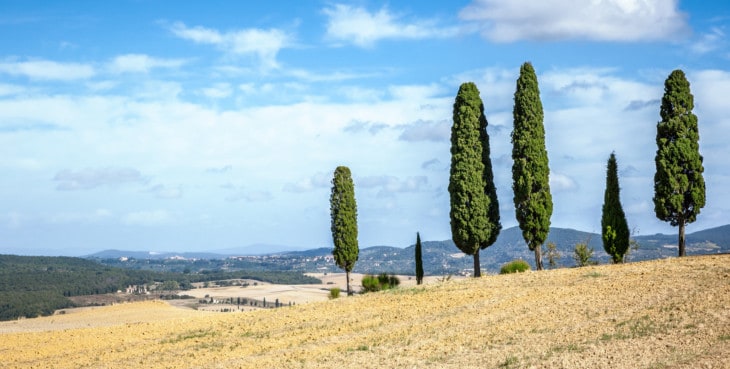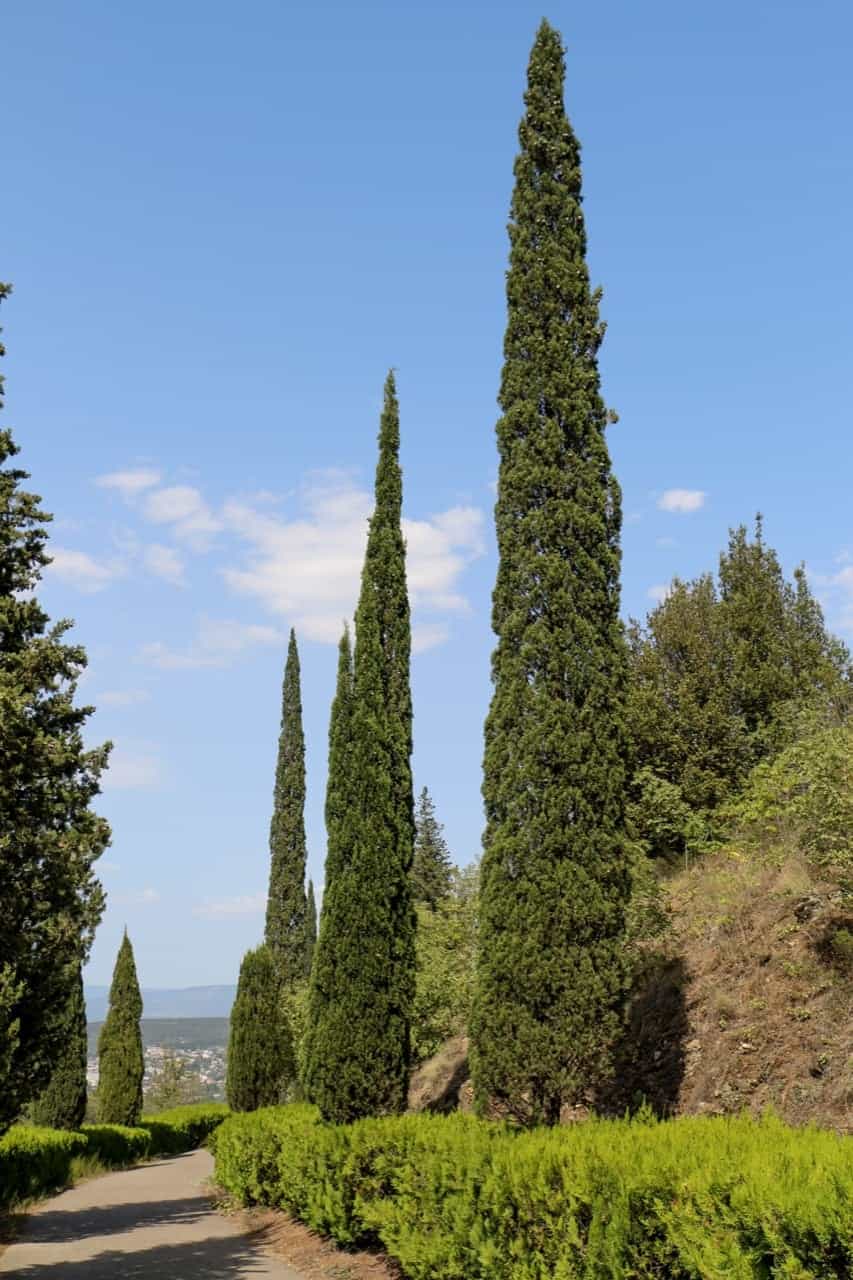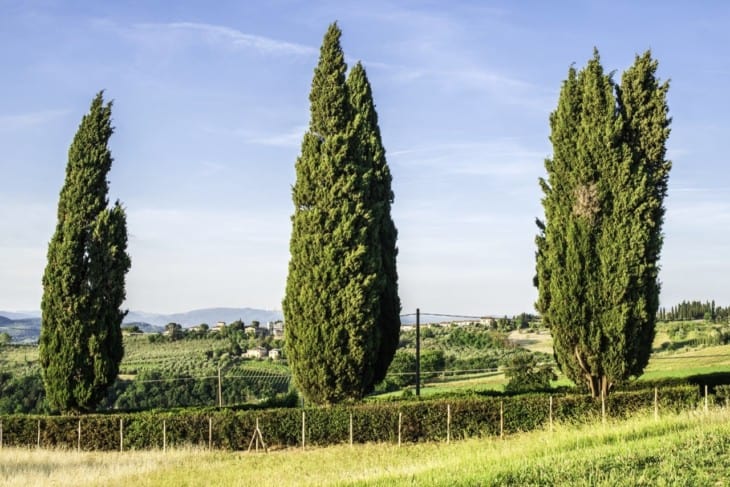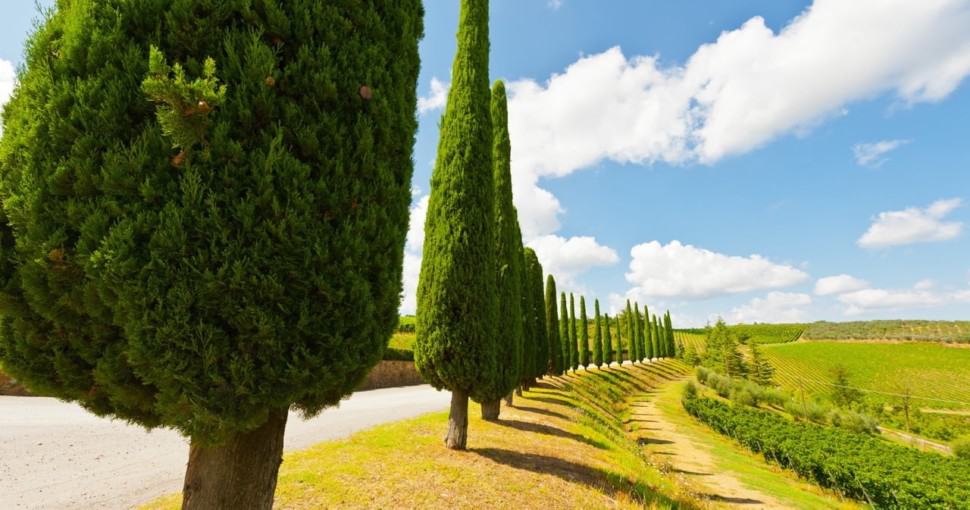Italian cypress trees (Cupressus sempervirens) are tall, graceful trees sometimes known as the Persian cypress, Mediterranean cypress, Tuscan cypress, or Pencil pine. They are popular in graveyards and, because of this, are sometimes called Churchyard cypress. This is undoubtedly a tree with many names. If you are considering planting an Italian cypress tree, it is wise to look at its pros and cons.
The Italian cypress tree has many pros, including that it is evergreen, has a graceful columnar shape, is fire resistant, and is fast growing. A con is that the tree has specific climate needs, can be prone to certain diseases and parasites, and its shape and size may not suit your garden.
It is important to know as much about a tree as possible before choosing to plant it. Investigating the Italian cypress tree allows you to make an informed decision on the appropriateness of the tree for your garden.
This article is specific to the unique columnar shape of the Italian Cypress tree. We also have an article about the benefits of Cypress trees which covers the general type.
Pros Of Italian Cypress Trees

1: The Italian Cypress Is Evergreen
An evergreen tree is a benefit in any garden. They provide color during the dark, gloomy days of winter and enhance the form in the garden throughout the year.
The Italian cypress is coniferous and has scale-like leaves, which allow it to withstand both cold and hot conditions. This resilience enables the tree to be a long-lived tree. Some specimens are reported to be more than one thousand years old.
The leaves remain a rich dark green throughout the year. The cones are initially green and become brown with age providing added interest to the tree.
The Italian cypress is an excellent tree to plant as a windbreak; summer or winter, it does its job because the branches are never bare.
Evergreens, like the Italian cypress, help maintain the ecosystem in your garden. They provide shelter for birds and other wildlife, protect smaller creatures from predators, and are good places for nesting sites.
The Italian cypress makes oxygen through photosynthesis all through the year. In this way, it adds to the air quality in the area. They have an aromatic resin that is pleasant smelling and adds to the garden scents in winter and summer.

2: Italian Cypress Trees Have A Columnar Shape
Italian cypress trees grow like elegant columns. They have only one trunk, and no limbs branch outwards from the trunk. All the branches follow a narrow upward direction.
This makes them particularly useful for highlighting specific areas or drawing attention to a feature such as the architecture of a house.
They look like sentinels, and many people use them to demarcate the borders of an area or line a driveway. Their height of 115 feet (35 meters) adds to this idea of the trees acting as guards.
The solemn sentinel aspect of the tree has made them popular for use around graveyards and churches.
3: Italian Cypress Are Fire Resistant
In 2012 a wildfire swept through a plantation used for research by Spanish scientists. All the other trees burned but the copse of Italian cypress trees remained standing.
These cypress trees were still green and showed no damage from the devastating fire. Only 1,2% of the Italian cypress trees had ignited – a remarkable fact compared to the neighboring trees of different species.
The structure of the Italian cypress leaves allows it to hold a lot of water and therefore makes it resilient to high temperatures. The leaf cuticle is thick, and leaf openings occur on the inner protected surface of the scale-like leaf. Water is therefore not easily lost through evaporation and heat.
These trees would cope well even in drought and sweltering summers. The high water content lessens the chances of the tree igniting during a bush fire.
Leaf litter at the foot of the Italian cypress forms a thick spongy mat that retains water. This feature acts as a fire retardant as it cannot be used as fuel for flames.
Although no trees are truly fire-resistant, the Italian cypress is regarded as the most fire retardant or resilient tree in the world.
4: Italian Cypress Are Fast-Growing
It is helpful to plant fast-growing trees as they can soon perform the function for which you planted them. The Italian cypress is considered a fast-growing tree as they grow about three feet per year.
If you plant Italian cypress trees for a windbreak or fire-retardant strip, you will not have long to wait before they can fulfill their function.
Cons Of Italian Cypress Trees

As with most things in life and nature, everything which has pros also has cons. This is also true for the Italian Cypress tree. If you want to mitigate this, have a look at these Italian Cypress tree alternatives.
1: Italian Cypress Need Specific Climates
Although Italian cypress can grow in a variety of different soils, they are more demanding about climatic conditions. These trees do best in hot climates such as California or Mediterranean regions.
They do not do well in cold, wet climates where they grow slowly and are prone to diseases.
2: Italian Cypress Are Prone To Diseases
Italian cypress trees are prone to canker fungi and bacterial infection. Initially, the disease is first seen on the branches. However, it is not unheard of for the tree trunk to show large patches in the initial phases of the disease.
Cankers decimated Italian cypress trees in certain regions. It is essential to treat a tree for canker as soon as it is detected.
Wet, cold climatic conditions make Italian cypress trees susceptible to root rot. The branches wilt, turn yellow, and die rapidly. Treatments can be applied at the base of the trunk, or the soil can be dug out to expose the roots and allow them to dry.
Italian cypress trees are vulnerable to pests such as red spider mites, scales, and bagworms.
3: Italian Cypress Shape And Size Are Unsuitable
For some people, the tall, slender shape of the Italian cypress is ideal. In other instances, its form may detract from its suitability. It is not a good shade tree or a good choice for a small garden.
The tall tree may tower over a small garden and dominate the other garden features. Several Italian cypress trees would be needed to cover an undesirable structure. In contrast, a leafy bushy shrub may do a much better job.
The height of an Italian cypress may look ridiculous against the background of a squat single-story house.







